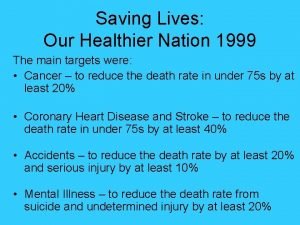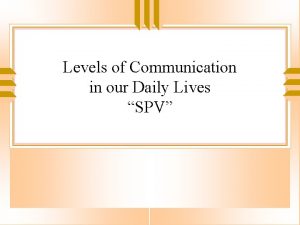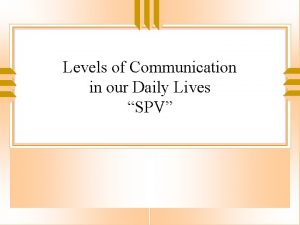Levels of Communication in our Daily Lives SPV























- Slides: 23

Levels of Communication in our Daily Lives “SPV”

Standards and Objectives Standard: ARR 2. 0 - ARFL 4. 00 Students will identify effective communication in interpersonal relationships. Objectives: • Identify various types of communication styles. • Define the levels of communication

Levels of Communication 1. Make a small circle with the groups I have organized. 2. Everyone must participate. 3. No talking with other groups. 4. Everyone must listen with their eyes. 5. When I call time you must stop where you are. 6. If you have not finished the previous round, finish it and then move on.

Round #1 • Share an event you have experienced. • Example:

Round #2 • Describe a situation that has proven to be a good INFLUENCE on your life. • Example:

Round #3 • Describe a quality you already have that will make you a better parent or spouse. • Example:

Round #4 • You must give a compliment to one other person in your group. • Example

Levels of Communication Discussion

Levels of Communication • Event Superficial • Influence Personal • Personal Quality Validating • Compliment

Levels of Communication “SPV” Superficial Communication making up the majority of our communication. Talking about the weather, Personal home, school, food, etc. Communication involving opening up and talking about feelings, beliefs and opinions that mean something to you. Validating Communication reinforcing people’s feelings about themselves.

Levels of Communication Questions 1. 2. 3. 4. 5. 6. Can a relationship remain stable for an extended period of time if they communicate in a superficial state? Why? Which levels of communication must a relationship strive for in order to grow? Why? Which was more difficult to share in group? Events, Influences, Personal qualities, Compliments. Why? What are some reactions that occurred in your group? Explain why these occurred. Why is it more difficult to share personal qualities and compliments. Why would you communicate superficially?

“You can tell more about a person by what he says about others than you can by what others say about him. ” --Leo Aikman

Video clips

Video Clips • Goonies • Say Anything • Singles • Validating • Reality Bytes • Sleepless in Seattle • Superficial into Personal ( Proximity closer) • Superficial to Personal

1. What kind of communication makes up majority of our conversations? 2. What kind of communication makes a relationships stronger? 3. What is validating Communication?

Reasons for keeping Communication Superficial: • • • I may be hurt. I don’t want to hurt their feelings. They will misinterpret what I say. They won’t be receptive It will put our relationship at risk. I will be out on a limb and won’t be supported. http: //www. mnadr. state. mn. us/workplace/pdf/Keepcomm. pdf

What Validation Is • To validate someone's feelings is first to accept someone's feelings. Next, it is to understand them, and finally it is to nurture them.

Basic Steps to Validation • • • Acknowledging the other person's feelings Identifying the feelings Offering to listen Helping them label the feelings Being there for them; remaining present physically and emotionally • Feeling patient • Feeling accepting and non-judgmental

Example of Validating • I hear you. That hurts That's not good • Wow, that's a lot to deal with I would feel the same way. (I would be sad/hurt/angry/jealous, etc. too) • That is sad. That sounds discouraging. That sounds like it would really hurt That must really hurt. • I know just what you mean. I would feel the same way. I can understand how you feel. It sounds like you are really feeling ____. It sounds like is really important to you.

Validating necklaces Students talk to one another about their admirable qualities and traits they see in each other. They must validate their compliments. Each time they validate someone they get a piece of yarn tied to their necklaces.

Painful feelings that are expressed, acknowledged and validated by a trusted listener will diminish. Painful feelings that are ignored will gain strength. (1)

• “No man means all he says, and yet very few say all they mean, for words are slippery and thought is viscous. ” • Henry B. Adams

Summary: • What is SPV? • The greater the need to communicate our feelings, the harder it is to do. Indeed, sharing our opinions and emotions is risky business. We minimize the risk when we move through the levels of communication incrementally. That is, each conversation ought to begin with phatic (superficial) communication and move through the levels (however quickly seems appropriate) before moving to the more intimate levels. • Generally, we look for the other individual to reciprocate at the same level of intensity. There is a social convention to match levels. If the other initiates a conversation at the evaluative level, we often feel compelled to respond in kind. This is dangerous. • Sharing our ideas and feelings is generally reserved for those whom we trust. Trust is a function of confidence, commitment, and time. We generally share our essence with those we’ve known a long time. (2)
 Energy in our daily lives
Energy in our daily lives Eye contact is woven into the fabric of our daily lives.
Eye contact is woven into the fabric of our daily lives. épreuve bts aménagement paysager
épreuve bts aménagement paysager Spv adalah
Spv adalah The mass media play an important part in our lives
The mass media play an important part in our lives Drawing the power of jesus christ in our lives
Drawing the power of jesus christ in our lives Good 6 word memoirs about sports
Good 6 word memoirs about sports Tissue imtiaz dharker context
Tissue imtiaz dharker context What role does nature play in our lives
What role does nature play in our lives During our lives, we produce three kinds of hair:
During our lives, we produce three kinds of hair: God's work in our lives
God's work in our lives Saving lives our healthier nation
Saving lives our healthier nation Does weight affect projectile motion
Does weight affect projectile motion Information technology in everyday life
Information technology in everyday life Practical applications of polynomials
Practical applications of polynomials Section 8-3 guidelines for healthful eating
Section 8-3 guidelines for healthful eating Villanelle examples
Villanelle examples Costa's level 3 questions examples
Costa's level 3 questions examples Thinking language and intelligence
Thinking language and intelligence Our census our future
Our census our future Christ, be our light shine in our hearts
Christ, be our light shine in our hearts Marcus aurelius our life is what our thoughts make it
Marcus aurelius our life is what our thoughts make it We bow our hearts
We bow our hearts Our census our future
Our census our future













































